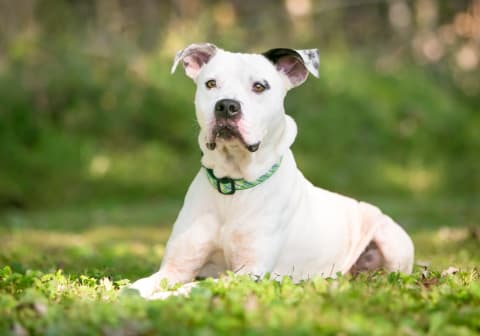What is the ACL in dogs called?
The anterior cruciate ligament (ACL) is a thin connective tissue in the middle of our knees which connects the lower leg bone to the upper leg bone.
In dogs we call this connective tissue is called the cranial cruciate ligament (CCL). As with a person's ACL, the CCL connects the dog's tibia (bone below the knee) to their femur (bone above the knee).
One of the primary differences between a person's ACL and a dog's CCL is that, due to the angle of the dog's back legs when they are standing, walking, or running their CCL is always load bearing.
What are the differences between ACL & CCL injuries?
ACL injuries are particularly common in athletes. These injuries generally occur due to an acute trauma stemming from a sudden movement such as a change of direction while running, or jumping.
Dog CCL injuries typically come on gradually rather than suddenly, and tend to become progressively worse with activity.
What are the symptoms of an ACL injury in dogs?
It's important to note that, because people are accustomed to ACL injuries, it is common to refer to CCL injuries in dogs as an ACL injury.
The most common signs of an ACL injury in dogs are:
- Lameness and limping in the hind legs.
- Stiffness, often most noticeable after rest, following exercise.
- Difficulty rising up off the floor or jumping.
If your dog is suffering from a mild ACL injury, it is likely to become worse over time with symptoms becoming more pronounced. If left untreated a mild ACL injury will likely lead to a very painful tear.
Unfortunatly, dogs suffering from a single torn ACL typically begin to favor the non-injured leg during activity which often leads to the second leg also becoming injured. It is estimated that 60% of dogs with a single ACL injury will soon go on to injure the other knee.
How are dog ACL injuries treated?
There are a number of effective treatments available for dogs diagnosed with an ACL injury. When determining the best treatment for your dog's injury, your vet will take your dog's lifestyle and energy level into consideration, as well as your dog's age, size, and weight.
What are the available ACL treatment options for dogs?
Knee Brace:
- Treating an ACL injury with a knee brace is a non-surgical option that may help to stabilize the knee joint, and give the ligament time to scar over and repair itself. In order to be effective, a knee brace should be combined with dramatically reduced activity levels, which can be difficult for many dogs.
Extracapsular Repair - Lateral Suture
- This type of ACL surgery is typically recommended for small to medium sized dogs weighing less than 50lbs and involves replacing the torn ligament with an artificial ligament on the outside of the joint.
Tibial Plateau Leveling Osteotomy - TPLO
- With TPLO surgery the need for the CCL ligament is eliminated by cutting and flattening the tibial plateau (the top section of the tibia), then stabilizing it in a new position with the help of a plate and screws.
Tibial Tuberosity Advancement - TTA
- TTA surgery also eliminates the need for the CCL ligament by cutting the top of the tibia, moving it forward, and then stabilizing it in its new position with a a stainless steel metal plate.
How long will it take for my dog to recover from ACL surgery?
Some dogs will recover more quickly than others following ACL surgery. However, recovery from an ACL surgery is always a long process! While your dog may be able to walk as soon as 24 hours following surgery, expect full recovery and a return to normal activities to take 16 weeks or longer.
It's important to pay attention to your dog's healing process and follow your vet's advise. Never force your dog to do exercises if they resist as this can lead to re-injuring the leg.
If your dog is showing signs of a torn or injured ACL contact your Southeast Memphis vet to book an appointment.

Looking for a vet in Southeast Memphis?
We're always accepting new patients, so contact our veterinary hospital today to book your pet's first appointment.
Related Articles View All
How can a dog get rabies? What are the signs?
Rabies is a fatal, highly contagious, virus that can affect dogs, cats, livestock and humans! What are the signs your dog has rabies? What should you do? Read on to find out.
Signs that Your Dog May Have an Ear Infection
Dog ear infections need treatment quickly to prevent the condition from becoming more severe, or causing recurring infections in the future. So, how can you tell if your dog has an ear infection? Read on to find out.
How often should I take my dog to the vet?
Taking your dog to the vet regularly is a proactive way to help your pet live a long and healthy life, but how often should you take your dog to the vet? And, how can you save money on these routine appointments? Read on to find out.
Puppy Shots Schedule - When To Get Your Puppy Vaccinated
Vaccinations play an essential role in protecting your puppy's health in their first year of life. Here, you will find vital information about puppy vaccines and a schedule to help you plan for your puppy's shots.
Should I microchip my dog?
If your dog is lost or stolen, a microchip sitting under their skin can increase their chances of being returned to you. Not sure if you should get your four-legged friend microchipped? Below, we look at some of the reasons why many vets recommend microchipping for dogs.
